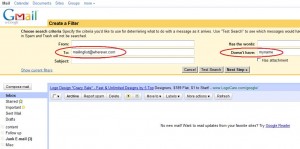Filtering Mailing List Messages with Gmail
Posted on Jun 14, 2011 in Tech Tips & Tricks | 0 comments

If you’re on any mailing lists, you realize they can fill your inbox quickly and distract you. Creating filters in Gmail is easy. Here are some ideas on how you may want to use them.
Targeting a Mailing List
Often, mailing list messages will always come from–or be going to–a mailing list address. You can set the filter to be active for any email from (or to) that special email address.
But what if there is no special address? What if someone from a group you visited once in another state emails you and 50 other people by individual emails on a regular basis?
Hopefully they make sure to include the name of the group in the subject line or body of the email, and you can have that in the filter criteria.
Or the emails may only come from a few specific individuals.
Or, if the email is sent to a group of individual emails (which is poor form) then you can pick out one of the email addresses it’s often sent to–someone you typically never correspond to–and have the filter screen any messages that are sent to that person (as well as you, of course).
Custom Label
Keep your inbox organized–you can set the filter to send all the messages to a specific label, and “archive” them (remove them from the inbox).
Depending on how interested you are in the list, you might set the filter to mark those messages as read. If you leave them unread, then in your list of labels you will see how many unread messages you have there. Then, arguably, you could notice that you have new messages in that label and read them… when you have time, someday.
If nothing else, those messages are in your email and the contents will turn up in searches, or you can turn to them if anyone ever asks “didn’t you get the email about x?”
Name-specific Screening
This works better for some people than others, but with some mailing lists I like to set it to send the messages to a custom label, archive them and mark them as read–so I never even see them–unless the email contains my name. Then if someone in the group says “Wasn’t Chad working on that?” then the message goes to my inbox; if it’s something that doesn’t refer to me specifically, then I never see it. Naturally, that tends to work best if there aren’t other people in the group with your name.



